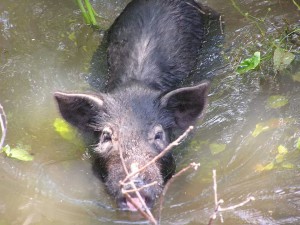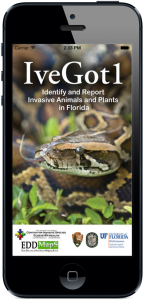Digital devices have proliferated like kudzu in July, and new user applications for these devices are as common as armadillos. Untold hours and dollars are being spent by couch potatoes to defend artificial worlds from dragons, zombies and other imaginary invaders.
Meanwhile, real exotic aliens from air potatoes to monitor lizards are invading Florida.
Don’t panic; there is some good news. A group of new applications that can help citizen scientists identify, locate and manage invasive plant and animal species in Florida is available for free.
The first line of defense is identifying and mapping new occurrences of invasive species. Many, if not most, new infestations were established before anyone noticed or cataloged them, and effective control strategies depend on knowing the extent of new infestations.
The Early Detection & Distribution Mapping System (EDDMapS) has been available at http://www.eddmaps.org since 2005. In the words of its developers, Charles Bargeron and David Moorehead of the University of Georgia’s Bugwood Network, the system was designed to: “develop more complete local, state and regional level distribution data of invasive plants, identify “leading edge” ranges of new invasive threats, provide a means of implementing early detection and response, and help corroborate threats and refine invasive plant lists and management priorities.”
“IveGot1” was developed by this same group through a cooperative agreement with the National Park Service in cooperation with the Florida Fish and Wildlife Conservation Commission and the University of Florida Center for Aquatic and Invasive Plants. The application is now available on both Apple and Android operating systems. The app includes invasive plants and animals and allows direct reporting of sightings as well as back ground information on Florida’s most common invasive species.

The impact of wild hogs on the environment is soil erosion, decreased water quality, spread of other invasive plants, damage to agricultural crops, and damage to native plants and animals. Photo by Jennifer Bearden
At least two other apps useful for invasive species management are also available. “Invasive Plants in Southern Forests” is adapted from the US Forest Service book of the same name. This publication is available for download at http://www.srs.fs.usda.gov/pubs/gtr/gtr_srs062, but it’s a big file (33MB). In addition to its ID function, the app includes appropriate control methods for the over 100 invasive trees, shrubs, vines, grasses and forbs described. As of now, this application is only available for the iPhone platform.
The second app is for Florida’s most widespread invasive animal. Although pythons may be our most infamous invasive animal, they don’t have the distribution of the wild hog. “Squeal on Pigs” combines a location app and educational information to support states’ efforts to control wild hog populations and reduce their impacts on streams and crops.
Maybe you won’t reach Destroyer level in the real battle on air potatoes and Florida’s other invasive species, but moving from Angry Birds to Squeal on Pigs will raise your power level as a Friend of Real Florida.

